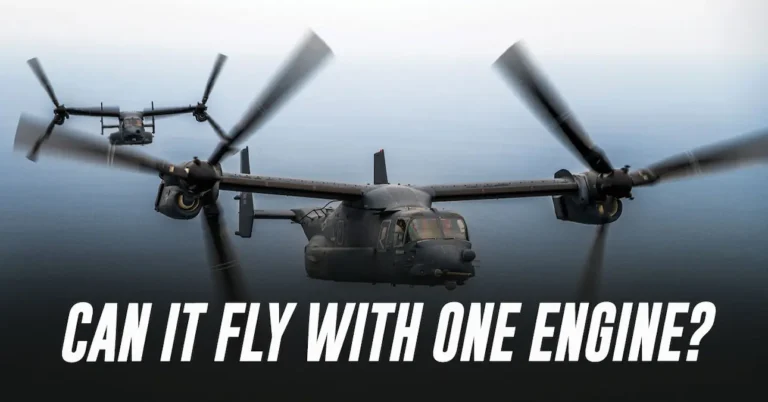The Bell Boeing V-22 Osprey was a groundbreaking aircraft when it first took flight in 1989, becoming the world’s first successful military tiltrotor aircraft. It combines the vertical takeoff and landing (VTOL) capabilities of a helicopter with the range and speed of a turboprop plane- the best of both worlds.
Powered by two Rolls-Royce engines, its unique tiltrotor system allows it to switch between helicopter and airplane modes, offering greater flexibility in combat and transport missions. However, despite its technological advancements, the aircraft has faced significant operational and safety challenges. Is it the complex engineering to blame? More importantly, can a V-22 Osprey fly with just one engine?
Table of Contents
The Revolutionary Dual-Engine Design
The V-22 is powered by two Rolls-Royce Liberty AE1107C engines, each producing over 6,200 shaft horsepower. These drive twin rotors, each with a massive 38-foot diameter, allowing the aircraft to take off and land vertically like a helicopter, and further hover and cruise at high speeds.
ALSO READ: Antonov AN-225 Mriya: Looking Back At What Was The World’s Largest Operational Aircraft!
One of the key highlights of the Osprey is the complex engineering that has gone into its interconnected drive system. This allows power from one engine to be transferred to both rotors via a central gearbox. This means that if one engine fails, the remaining engine can keep both rotors turning, allowing the aircraft to continue flying.
Flying with One Engine: Possible, But Risky
In forward flight—when the nacelles are rotated forward and the Osprey is functioning like a fixed-wing aircraft—it can continue flying with just one engine. The interconnected drivetrain ensures that power is still supplied to both rotors, maintaining lift and thrust. However, flying in this condition requires careful adjustments, such as reducing speed and altitude to conserve power.
The real challenge comes when the Osprey needs to hover or perform a vertical takeoff or landing with only one engine. Hovering requires significant thrust, and with just one engine, the aircraft may struggle to generate enough of it—especially if it is carrying a full load of troops or cargo. Under certain conditions, the V22 may be able to hover briefly, but it would need to be at a low altitude and carry minimal weight to do so safely.
The Risk of Engine Failure
While the Osprey’s redundancy system is designed to handle an engine failure, real-world incidents have shown that such failures can be dangerous. The aircraft has had a troubled safety history, with multiple crashes linked to mechanical issues, including problems with the clutch in the rotor gearbox.
One particular issue, known as the “hard clutch engagement,” has been identified as a cause of some major V-22 mishaps. This occurs when the clutch temporarily disengages from the rotor system and then suddenly reengages, leading to a sudden loss of lift and control. Although the aircraft is designed to handle engine failures, unexpected mechanical problems can make it difficult to recover from such situations.
Pilots Are Trained Extensively
Given the ‘infamous’ history of the aircraft, Osprey 22 pilots are trained extensively to handle malfunctions, ensuring that they can safely land or transition to forward flight in the event of an emergency.
How Does The V22 Osprey Work?
So, how does the V22 Osprey function? Well, it takes off and lands like a helicopter. To do this, the aircraft’s nacelles (which house the engines and rotors) rotate to a fully vertical position. In this configuration, the rotors generate lift directly upward, allowing the Osprey to hover, take off, or land without needing a runway.
Once airborne, it begins transitioning from helicopter mode to aeroplane mode. The nacelles slowly rotate forward, changing the angle of the rotors. As this happens, the aircraft begins gaining forward speed, and the fixed wings start generating lift.
By the time the nacelles are fully horizontal, the aircraft starts functioning like a conventional aeroplane, with its wings providing lift and the rotors acting as powerful propellers. The Osprey can thus fly faster ( nearly twice as fast as traditional helicopters) and have a longer range than helicopters. It is even more fuel-efficient than most military helicopters.
When preparing to land, the aircraft reverses the transition process. The Nacelles slowly tilt back to a vertical position, shifting the reliance from wing-generated lift to rotor-generated lift. This allows for precise landings in confined spaces where traditional planes cannot operate.
